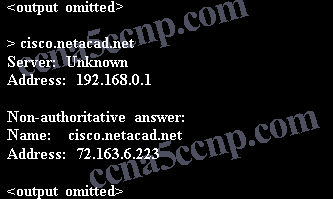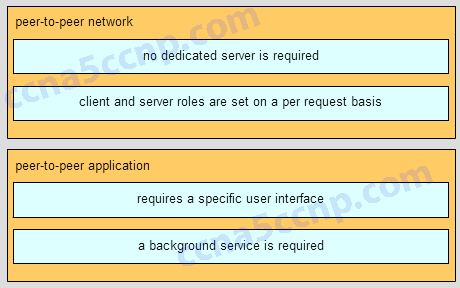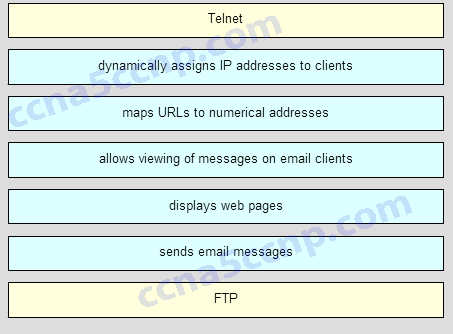Last Updated on April 5, 2018 by Admin
CCNA1 Chapter 10 Exam Answer 2016 v5.1
From year to year, Cisco has updated many versions with difference questions. The latest version is version 6.0 in 2018. What is your version? It depends on your instructor creating your class. We recommend you to go thought all version if you are not clear. While you take online test with netacad.com, You may get random questions from all version. Each version have 1 to 10 different questions or more. After you review all questions, You should practice with our online test system by go to "Online Test" link below.
| Version 5.02 | Version 5.1 | Version 6.0 | Online Assessment |
| Chapter 10 Exam | Chapter 10 Exam | Chapter 10 Exam | Online Test |
| Next Chapter | |||
| Chapter 11 Exam | Chapter 11 Exam | Chapter 11 Exam | Online Test |
| Lab Activities | |||
| 10.2.1.7 Packet Tracer – Web and Email | |||
| 10.2.2.7 Packet Tracer – DNS and DHCP | |||
| 10.2.3.3 Packet Tracer – FTP | |||
| 10.3.1.2 Packet Tracer – Explore a Network | |||
| 10.3.1.3 Packet Tracer Multiuser – Tutorial – Client Side | |||
| 10.3.1.4 Packet Tracer Multiuser – Implement Services – Client Side | |||
-
Which two definitions accurately describe the associated application layer protocol? (Choose two.)
- SMTP – transfers web pages from web servers to clients
- Telnet – provides remote access to servers and networking devices
- DNS – resolves Internet names to IP addresses
- FTP – transfers email messages and attachments
- HTTP – enables devices on a network to obtain IP addresses
Explanation: The Domain Name Service (DNS) protocol resolves Internet names to IP addresses. Hypertext Transfer Protocol (HTTP) transfers files that make up the web pages of the World Wide Web. The Simple Mail Transfer Protocol (SMTP) transfers mail messages and attachments. Telnet, a terminal emulation protocol, provides remote access to servers and networking devices. The File Transfer Protocol (FTP) transfers files between systems.
-
The application layer of the TCP/IP model performs the functions of what three layers of the OSI model? (Choose three.)
- physical
- session
- network
- presentation
- data link
- transport
- application
Explanation: The network access layer of the TCP/IP model performs the same functions as the physical and data link layers of the OSI model. The internetwork layer equates to the network layer of the OSI model. The transport layers are the same in both models. The application layer of the TCP/IP model represents the session, presentation, and application layers of the OSI model.
-
Which layer in the TCP/IP model is used for formatting, compressing, and encrypting data?
- internetwork
- session
- presentation
- application
- network access
Explanation: The application layer of the TCP/IP model performs the functions of three layers of the OSI model – application, presentation, and session. The application layer of the TCP/IP model is the layer that provides the interface between the applications, is responsible for formatting, compressing, and encrypting data, and is used to create and maintain dialogs between source and destination applications.
-
What are two characteristics of the application layer of the TCP/IP model? (Choose two.)
- responsibility for logical addressing
- responsibility for physical addressing
- the creation and maintenance of dialogue between source and destination applications
- closest to the end user
- the establishing of window size
Explanation: The application layer of the TCP/IP model is the layer that is closest to the end user, providing the interface between the applications. It is responsible for formatting, compressing, and encrypting data, and is used to create and maintain dialog between source and destination applications.
-
A manufacturing company subscribes to certain hosted services from its ISP. The services that are required include hosted world wide web, file transfer, and e-mail. Which protocols represent these three key applications? (Choose three.)
- FTP
- HTTP
- DNS
- SNMP
- DHCP
- SMTP
Explanation: The ISP uses the HTTP protocol in conjunction with hosting web pages, the FTP protocol with file transfers, and SMTP with e-mail. DNS is used to translate domain names to IP addresses. SNMP is used for network management traffic. DHCP ic commonly used to manage IP addressing.
-
What is an example of network communication that uses the client-server model?
- A user uses eMule to download a file that is shared by a friend after the file location is determined.
- A workstation initiates an ARP to find the MAC address of a receiving host.
- A user prints a document by using a printer that is attached to a workstation of a coworker.
- A workstation initiates a DNS request when the user types www.cisco.com in the address bar of a web browser.
Explanation: When a user types a domain name of a website into the address bar of a web browser, a workstation needs to send a DNS request to the DNS server for the name resolution process. This request is a client/server model application. The eMule application is P2P. Sharing a printer on a workstation is a peer-to-peer network. Using ARP is just a broadcast message sent by a host.
-
Two students are working on a network design project. One student is doing the drawing, while the other student is writing the proposal. The drawing is finished and the student wants to share the folder that contains the drawing so that the other student can access the file and copy it to a USB drive. Which networking model is being used?
- peer-to-peer
- client-based
- master-slave
- point-to-point
Explanation: In a peer-to-peer (P2P) networking model, data is exchanged between two network devices without the use of a dedicated server.
-
What do the client/server and peer-to-peer network models have in common?
- Both models have dedicated servers.
- Both models support devices in server and client roles.
- Both models require the use of TCP/IP-based protocols.
- Both models are used only in the wired network environment.
Explanation: In both the client/server and peer-to-peer network models, clients and servers exist. In peer-to-peer networks, no dedicated server exists, but a device can assume the server role to provide information to a device serving in the client role.
-
What is an advantage for small organizations of adopting IMAP instead of POP?
- Messages are kept in the mail servers until they are manually deleted from the email client.
- When the user connects to a POP server, copies of the messages are kept in the mail server for a short time, but IMAP keeps them for a long time.
- IMAP sends and retrieves email, but POP only retrieves email.
- POP only allows the client to store messages in a centralized way, while IMAP allows distributed storage.
Explanation: IMAP and POP are protocols that are used to retrieve email messages. The advantage of using IMAP instead of POP is that when the user connects to an IMAP-capable server, copies of the messages are downloaded to the client application. IMAP then stores the email messages on the server until the user manually deletes those messages.
-
Which application layer protocol uses message types such as GET, PUT, and POST?
- DNS
- DHCP
- SMTP
- HTTP
- POP3
Explanation: The GET command is a client request for data from a web server. A PUT command uploads resources and content, such as images, to a web server. A POST command uploads data files to a web server.
-
When retrieving email messages, which protocol allows for easy, centralized storage and backup of emails that would be desirable for a small- to medium-sized business?
- IMAP
- POP
- SMTP
- HTTPS
Explanation: IMAP is preferred for small-to medium-sized businesses as IMAP allows centralized storage and backup of emails, with copies of the emails being forwarded to clients. POP delivers the emails to the clients and deletes them on the email server. SMTP is used to send emails and not to receive them. HTTPS is not used for secure web browsing.
-
Which three statements describe a DHCP Discover message? (Choose three.)
- The source MAC address is 48 ones (FF-FF-FF-FF-FF-FF).
- The destination IP address is 255.255.255.255.
- The message comes from a server offering an IP address.
- The message comes from a client seeking an IP address.
- All hosts receive the message, but only a DHCP server replies.
- Only the DHCP server receives the message.
Explanation: When a host configured to use DHCP powers up on a network it sends a DHCPDISCOVER message. FF-FF-FF-FF-FF-FF is the L2 broadcast address. A DHCP server replies with a unicast DHCPOFFER message back to the host.
-
What part of the URL, http://www.cisco.com/index.html, represents the top-level DNS domain?
- .com
- www
- http
- index
Explanation: The components of the URL http://www.cisco.com/index.htm are as follows:
- http = protocol
- www = part of the server name
- cisco = part of the domain name
- index = file name
- com = the top-level domai
-
Which two tasks can be performed by a local DNS server? (Choose two.)
- providing IP addresses to local hosts
- allowing data transfer between two network devices
- mapping name-to-IP addresses for internal hosts
- forwarding name resolution requests between servers
- retrieving email messages
Explanation: Two important functions of DNS are to (1) provide IP addresses for domain names such as www.cisco.com, and (2) forward requests that cannot be resolved to other servers in order to provide domain name to IP address translation. DHCP provides IP addressing information to local devices. A file transfer protocol such as FTP, SFTP, or TFTP provides file sharing services. IMAP or POP can be used to retrieve an email message from a server.
-
Which phrase describes an FTP daemon?
- a diagnostic FTP program
- a program that is running on an FTP server
- a program that is running on an FTP client
- an application that is used to request data from an FTP server
Explanation: An FTP server runs an FTP daemon, which is a program that provides FTP services. End users who request services must run an FTP client program.
-
Which statement is true about FTP?
- The client can choose if FTP is going to establish one or two connections with the server.
- The client can download data from or upload data to the server.
- FTP is a peer-to-peer application.
- FTP does not provide reliability during data transmission.
Explanation: FTP is a client/server protocol. FTP requires two connections between the client and the server and uses TCP to provide reliable connections. With FTP, data transfer can happen in either direction. The client can download (pull) data from the server or upload (push) data to the server.
-
What is true about the Server Message Block protocol?
- Different SMB message types have a different format.
- Clients establish a long term connection to servers.
- SMB messages cannot authenticate a session.
- SMB uses the FTP protocol for communication.
Explanation: The Server Message Block protocol is a protocol for file, printer, and directory sharing. Clients establish a long term connection to servers and when the connection is active, the resources can be accessed. Every SMB message has the same format. The use of SMB differs from FTP mainly in the length of the sessions. SMB messages can authenticate sessions.
-
Which application layer protocol is used to provide file-sharing and print services to Microsoft applications?
- HTTP
- SMTP
- DHCP
- SMB
Explanation: SMB is used in Microsoft networking for file-sharing and print services. The Linux operating system provides a method of sharing resources with Microsoft networks by using a version of SMB called SAMBA.
-
Fill in the blank.
What is the acronym for the protocol that is used when securely communicating with a web server? HTTPS
-
Fill in the blank.
The HTTP message type used by the client to request data from the web server is the GET message. -
Fill in the blank.
Refer to the exhibit. What command was used to resolve a given host name by querying the name servers?NSLOOKUP
-
Match a statement to the related network model. (Not all options are used.)
- Question
- Answer
Explanation: Peer-to-peer networks do not require the use of a dedicated server, and devices can assume both client and server roles simultaneously on a per request basis. Because they do not require formalized accounts or permissions, they are best used in limited situations. Peer-to-peer applications require a user interface and background service to be running, and can be used in more diverse situations.
-
Match the function to the name of the application. (Not all options are used.)
- Question
- Answer
-
Open the PT Activity. Perform the tasks in the activity instructions and then answer the question.
Which PC or PCs are sending FTP packets to the server?
- PC_3
- PC_1
- PC_2
- PC_1 and PC_3
Explanation: After you view the details of the packets that are being transferred between each PC and the server, you will see that the PC that is using a destination port number of 20 or 21 is the PC using the FTP service. PC_2 has an outbound port number of 21 to create an FTP control session with the server at 192.168.1.253.
From year to year, Cisco has updated many versions with difference questions. The latest version is version 6.0 in 2018. What is your version? It depends on your instructor creating your class. We recommend you to go thought all version if you are not clear. While you take online test with netacad.com, You may get random questions from all version. Each version have 1 to 10 different questions or more. After you review all questions, You should practice with our online test system by go to "Online Test" link below.
| Version 5.02 | Version 5.1 | Version 6.0 | Online Assessment |
| Chapter 10 Exam | Chapter 10 Exam | Chapter 10 Exam | Online Test |
| Next Chapter | |||
| Chapter 11 Exam | Chapter 11 Exam | Chapter 11 Exam | Online Test |
| Lab Activities | |||
| 10.2.1.7 Packet Tracer – Web and Email | |||
| 10.2.2.7 Packet Tracer – DNS and DHCP | |||
| 10.2.3.3 Packet Tracer – FTP | |||
| 10.3.1.2 Packet Tracer – Explore a Network | |||
| 10.3.1.3 Packet Tracer Multiuser – Tutorial – Client Side | |||
| 10.3.1.4 Packet Tracer Multiuser – Implement Services – Client Side | |||




